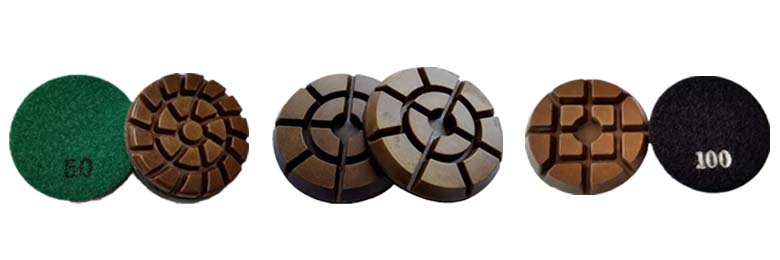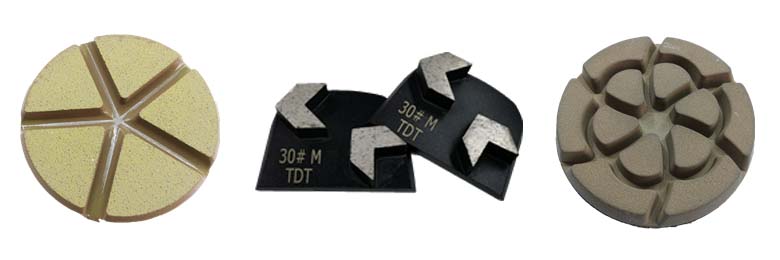Quality Inspection Of Diamond Grinding Tools2022-05-10
The main items of diamond grinding tools quality inspection include appearance, geometric dimension, balance and grinding performance inspection.
1. Visual inspection
The appearance inspection of abrasive tools refers to the use of a magnifying glass to observe whether there are defects on the surface of abrasive tools, the main content including cracks, mutes and edge damage on the surface of diamond layer, and whether the structure and color of the diamond layer are consistent.
When observing the working surface of the diamond grinding tools with a 20x magnifying glass with a scale, there should be diamond sharp edges exposed and evenly distributed. The area of each pit on the working surface should not exceed 1mm², and there should be no original skin, foaming, inclusions, etc. The surface of the bronze bond diamond grinding tools should be uniform and bright yellow, and no dark red oxidation spots or other spots are allowed.
There should be no mute sound when the diamond abrasive tool is struck. The judgment method often adopts the method of listening, that is, by tapping the abrasive tool, if there is a hoarse sound, it means that there may be hidden cracks inside the abrasive tool or between the diamond layer and the transition layer, between the pressing layer and the substrate.
The edge damage of the abrasive tool can be measured along the circumference, height and diameter by a square and a vernier. Abrasives with strict shape requirements are not allowed to have edge damage; for general abrasives with lax shape requirements, the maximum length of each edge drop shall not exceed 1/60 of the circumference, and for abrasives whose thickness is not greater than 10mm , the total length of the missing edge shall not exceed 1/15 of the circumference of the circumference, and if the thickness of the abrasive tool is greater than 10mm, the total length of the lost edge shall not exceed 1/10 of the circumference of the circumference.
For combined abrasive tools, the top of the assembly screw shall not be higher than the surface of the base.
2. Geometry Check
The outer diameter, thickness, aperture, thickness and width of the diamond abrasive tools, the angle and radian of various special-shaped abrasives, and the shape and position tolerance of the diamond abrasive tools should be checked.
The outer diameter, thickness, aperture, thickness and width of the diamond abrasive tools are all measured with a vernier caliper with an accuracy of 0.02mm, and the aperture is also measured with a plug gauge, an inner diameter gauge or an inner micrometer. The outer diameter and thickness of the abrasive tools are non-matching dimensions, and the dimensional accuracy is generally taken from the dimensional tolerance or measured according to the accuracy requirements of various manufacturers and processing drawings.
The matching accuracy of the hole diameter tolerance zone is generally based on the H7 standard hole, and the surface roughness is Ra> 1. 25 ~ 2. 50μm, but when the diameter of the abrasive tool is small (such as below 20mm) and the thickness is thin, the matching accuracy is correspondingly higher. , H9 and H13 are often used.
The angle ruler or sample plate is often used to check the angle of the abrasive tool. The angle ruler can measure the accurate angle, but it is more troublesome; the sample plate is actually a standard angle made of steel plate, which is very intuitive to check the angle of the abrasive tool, but the angle cannot be measured. The actual deviation is generally required to be within ± 2°.
The shape and size error inspection mainly includes unevenness, non-straightness and circular runout inspection. For some flat abrasives such as thin-film grinding wheels and cutting wheels, the unevenness must be checked. When testing, the abrasives are placed on the flat plate, and then measured with a flat ruler and a feeler gauge.
For abrasive tools with thick diamond tools, straightness is generally limited. The straightness error can be detected by a dial indicator, that is, let the tip of the needle bar of the dial indicator stand vertically on the outer surface of the abrasive tool and move along the axial direction. The maximum change in the pointer reading indicates the non-straightness of the abrasive tool. The measurement should be repeated several times from different positions, and the largest difference should be taken as the straightness of the mold.
The circular runout of the abrasive tool includes radial runout and end runout. The radial runout reflects the out-of-roundness of the abrasive tools or the non-axiality of the outer circle and the aperture; the end face runout reflects the unevenness of the abrasive tool or the non-perpendicularity between the end face and the aperture. The measurement of circular runout is carried out on a pendulum.
3. Dynamic balance check
When the grinding wheel rotates at high speed, if the center of gravity of the grinding wheel is too large, a large centrifugal force will be generated, which will cause the vibration of the grinding machine, reduce the quality of the processed products, and shorten the life of the grinding tool. For some thick abrasives, the static balance is acceptable, but dynamic imbalance may occur. Therefore, dynamic balance inspection must be carried out for diamond abrasive wheels with thicker thickness, larger diameter and combined type.
The dynamic balance inspection of abrasive tools is generally carried out on a special dynamic balancing machine. After using the dynamic balancing machine to measure the unbalanced position and the unbalanced amount of the grinding wheel, it can be corrected by the drilling support method or the weighting method, but the drilling should not exceed three places at most.
DTS Diamond Tools is a professional manufacturer of diamond tooling for concrete grinding and concrete polishing. We provide a wide range of diamond tooling on the market such as HTC tooling, Husqvarna tooling, Scanmaskin tooling, STI Prep/Master tooling, Klindex toooling, XPS tooling, Terrco tooling, Blastrac tooling, Diamatic tooling, Stonkor tooling with lowest cost and most reliable quality. If you are looking for a solution to your concrete floor, we can provide you with professional advice and guidance.

- Company Info
- Feedback
- Customer Reviews
- About Us
- Contact Us
- Blog
- Help Center
- User Center
- Forget Password
- My Orders
- Tracking Order
- My Account
- Register




